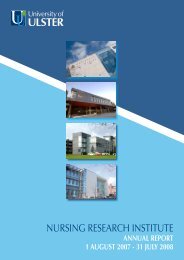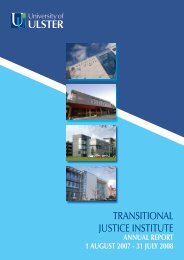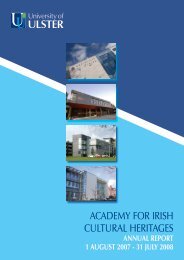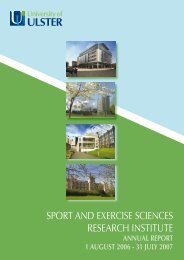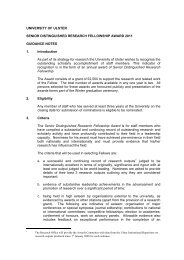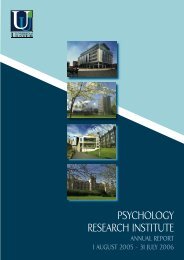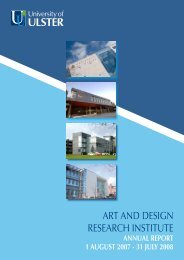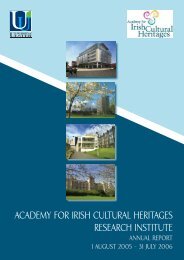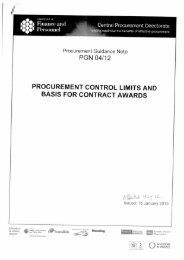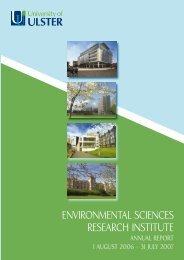biomedical sciences research institute - Research - University of Ulster
biomedical sciences research institute - Research - University of Ulster
biomedical sciences research institute - Research - University of Ulster
- No tags were found...
You also want an ePaper? Increase the reach of your titles
YUMPU automatically turns print PDFs into web optimized ePapers that Google loves.
MEMBERS OF THE GROUP:Academic StaffPr<strong>of</strong>essor Barbara Pierscionek, Group LeaderPr<strong>of</strong>essor <strong>of</strong> Optometry & Vision ScienceContact details:T: +44 (0)28 70323293b.pierscionek@ulster.ac.ukPr<strong>of</strong>essor Pierscionek works on the all aspects <strong>of</strong> the anterior eye involving a range <strong>of</strong> biochemical and biophysicalmethods.The optics <strong>of</strong> the lens and cornea have been studied using ray tracing and mathematical analysis (Eikonal equation) todetermine the refractive indices <strong>of</strong> these elements and how these varies across species and with age and development.The optics <strong>of</strong> the eye is dependent on its rheological (biomechanical properties) and Pr<strong>of</strong>essor Pierscionek, incollaboration with Dr Widlicka from the Wroclaw <strong>University</strong> <strong>of</strong> Technology have developed a means <strong>of</strong> measuringthe elastic properties <strong>of</strong> the cornea and sclera in an intact eyeball. Elasticity <strong>of</strong> the lens is being modelled using FiniteElement Analysis and based on experimental results from simulations <strong>of</strong> lens shape change (as it occurs in the eye).The link between optics and mechanics <strong>of</strong> the eye and how these alter with age, disease and surgery is a new field <strong>of</strong><strong>research</strong> which will be increasingly important as a national and international priority given the ageing population andthe growing demand for refractive surgery.Finite element lens:The functional (optical and mechanical) features are being studied in parallel with structural investigations <strong>of</strong> lensprotein distributions and how these change with growth and ageing in a variety <strong>of</strong> species. This work has resulted inestablishing collaborations with Pr<strong>of</strong>essor Michael Dunn and Dr Giuliano Elia from the Conway Institute in Dublin.The biochemical work also involves cell culture and investigations <strong>of</strong> the viability <strong>of</strong> DNA and chromosomal damagein response to chemical agents and quantum dots. This work is conducted in collaboration with Dr Wei Chen fromthe <strong>University</strong> <strong>of</strong> Texas in Arlington and with Dr Ronald Schachar from Pfizer. It will also involve collaborations withPr<strong>of</strong>essors McLaughlin and Meenan from the Nanotechnology <strong>Research</strong> Institute. This work is aimed at having afuture impact on better understanding the structure/function relationships <strong>of</strong> the anterior eye structures and howthese alter with age and disease.Cell CulturesIn addition, Pr<strong>of</strong>essor Pierscionek is investigating iris biometry in collaboration with Pr<strong>of</strong>essor Scotney and Dr Morrowfrom Computing and Engineering to design improved methods <strong>of</strong> identification. This addresses the internationalpriority in the biometrics as applied to issues <strong>of</strong> security, both national and international.109



